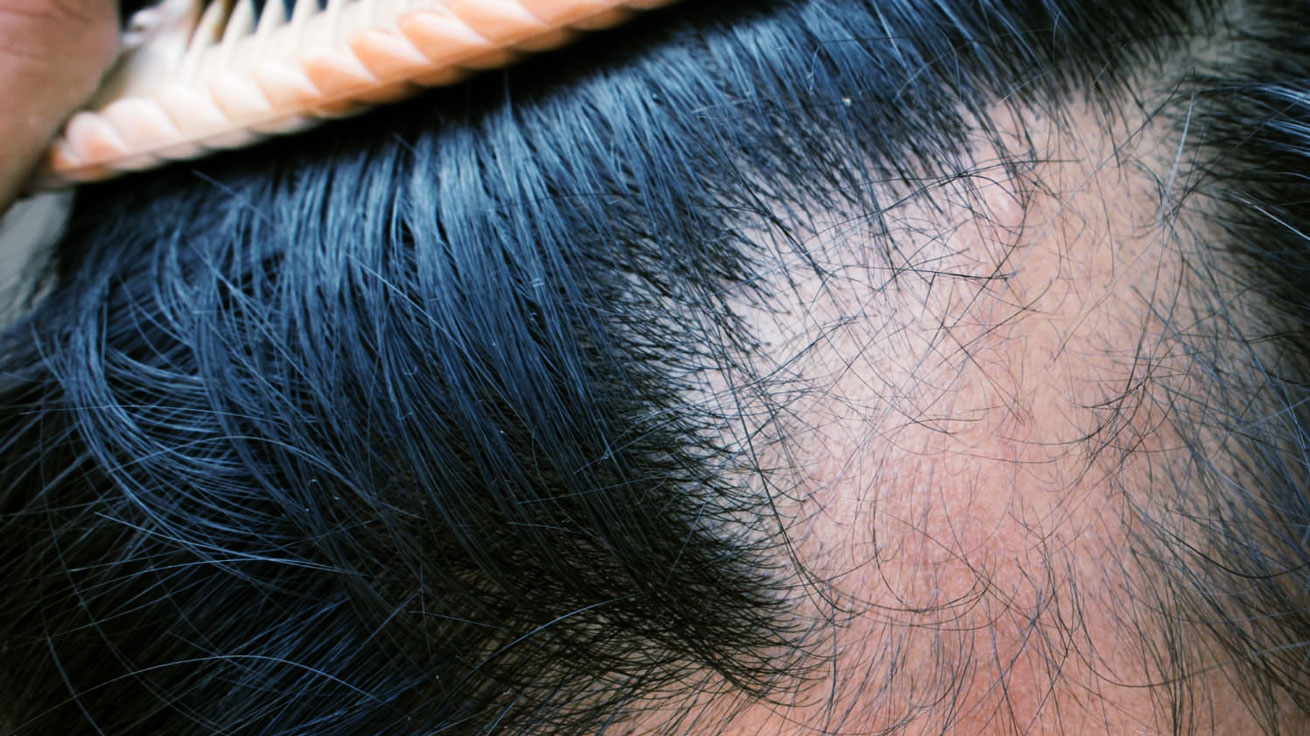- 54 VAS. SOFIAS AVENUE ATHENS 115 28
- (+30) 210 729 75 71
Alopecia

Alopecia is the loss of hair from anatomical locations where hair normally grows.
Hair grows in cycles in which periods of active growth (anagen phase) alternate with periods of rest (catagen phase) and regression (telogen phase). Factors that influence the life cycle of hair are the general state of health, diet, climate, seasons, age, gender and the care techniques and products used. An adult's scalp normally sheds approximately 50-100 hairs per day, while the loss of more hairs than this is called trichorrhoea.
Hair loss can be diffuse or localized, depending on its extent, as well as acute or chronic, depending on its duration. Another way to categorize alopecia is the presence or absence of inflammation along with scarring and atrophy. In this way, alopecias are divided into two major categories: non-scarring, which leads to reversible hair loss, and scarring, in which the destruction of the hair follicles is permanent. The first category includes androgenetic, alopecia areata, diffuse alopecia, traction alopecia, alopecia due to mycosis, etc. The second category includes lichen folliculitis, frontal fibrosing alopecia, discoid lupus erythematosus, neutrophilic alopecia, etc.
Diffuse hair loss can be either acute and caused by acute fever, major bleeding, major surgery, severe stress, systemic disease, childbirth, chemotherapy or radiotherapy, or chronic and caused by iron deficiency, nutritional or thyroid disorders, renal or hepatic failure, malignancies or various drugs. In addition, genetic and infectious factors, as well as autoimmune mechanisms, have been causally associated with various forms of alopecia.
The assessment of alopecia by the dermatologist is done by taking a detailed personal and family history and by clinical examination through special diagnostic techniques such as the hair pull and friction test, trichoscopy, trichoscanning and phototrichography, microscopy of the hair shaft and, in case of diagnostic concern, taking a biopsy for histological examination. In some cases, a blood test is recommended to determine iron, ferritin, thyroid hormones, etc., as well as a complete hormonal test to rule out hormonal disorders.
The treatment is long-term, individualized, differentiated according to the type of alopecia and aims both to inhibit further hair loss and, if possible, to regrow hair. For this purpose, various pharmaceutical agents, local and systemic, as well as special surgical techniques are available.
Early diagnosis and treatment of alopecia is considered particularly important, on the one hand because they are diseases that are often associated with underlying pathological disorders, and on the other hand because they often lead to a serious deterioration in the quality of life of the individual with psychosocial consequences.
ANDROGENIC ALOPECIA
Androgenetic alopecia is a progressive thinning of the hair on the head with a characteristic distribution, as it selectively affects the front part and the top of the scalp. It belongs to the non-scarring alopecias and is classified into the male type, which is more common, and the female type. In men, it usually worsens after 40 years, while in women it worsens after 50 years, and its frequency increases with age. It is estimated that at least 80% of men and 40% of women at the age of 70 suffer from this alopecia.
Etiologically, it is related to the combined effect of genetic predisposition and androgens on the hair follicles. The pattern of inheritance appears to differ between the sexes, and not all the responsible genes have been identified.
Clinically, in men, there is a receding frontotemporal line, thinning and eventually disappearance of hair in the temporal and parietal regions, as well as the crown of the head (male pattern). In women, there is a pronounced thinning of hair in the parietal region and the crown of the head, but the frontotemporal line is preserved (female pattern). Progressively, the hair in these locations becomes shorter, thinner and finally disappears, while the hair follicles shrink, leaving the skin of the scalp smooth. The inability to grow hair in length may be the first symptom of androgenetic alopecia.
The diagnosis of the disease is made by taking a detailed personal and family history, and a clinical dermatological examination with a hair pull test, trichoscopy and performing a trichoscanning or phototrichography. In many cases, a blood test is recommended, for the determination of iron, ferritin, thyroid hormones, etc., in order to exclude other types of alopecia, while in the case of women with signs of masculinization, a complete hormonal test is important to exclude disorders, such as polycystic ovary syndrome.
The treatment of androgenetic alopecia is long-term and aims to inhibit or slow down further hair loss and, if possible, regrowth. The earlier it is started, the better its results. Mainly, the topical use of minoxidil, which can be administered to both sexes, and the oral administration of pharmaceutical agents such as finasteride, which is officially approved for use only in men, are recommended. As an adjunct, the use of special shampoos and the intake of nutritional supplements with vitamins, trace elements and amino-acids are recommended. In recent years, surgical treatment with autologous transplantation of hair follicles from areas of the scalp that are not affected by the disease to areas that have undergone thinning, has been gaining more and more ground.
